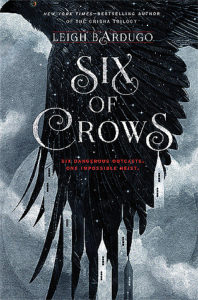
Leigh Bardugo may be the most popular author I’ve read in several years, with her hit Shadow and Bone Trilogy garnering a huge fanbase and ultimately resulting in a Netflix adaptation. But for all its popularity, Shadow and Bone is almost universally–at least in my circles–considered inferior to a later work in the same universe: The Six of Crows Duology. Last summer, Six of Crows served as my entry point back into YA fantasy, and despite taking a year to get around to the sequel (note: this is common for me), it definitely made me want to read more.
Six of Crows takes place in Bardugo’s Grishaverse, heavily inspired by Europe around the time of the Industrial Revolution, but with magic. The magic-users, called Grisha, are honored in Ravka, enslaved for use as weapons in neighboring Shu Han, and killed as witches in icy Fjerda. But the Six of Crows Duology takes place off the mainland and away from these three countries, revolving around Kerch, a Dutch-inspired island nation ruled by merchants, with violence, prostitution, and even human trafficking quietly tolerated as long as it doesn’t interfere with the profits. And Six of Crows sees six teenagers from the dregs of Kerch society attempt a heist that could make them fabulously wealthy—or get them all killed.
The duology features an ensemble cast, with third-person perspectives alternating between chapters. Kaz, a renowned lockpick and burgeoning crime lord, leads the group, bringing along Inej, a stealthy former acrobat who came to Kerch aboard a slave ship, sharpshooter Jesper, Grisha and former Ravkan soldier Nina, former Fjerdan soldier Matthias, and demolitions expert Wylan.
It’s not an unusual setup—a diversely talented band of thieves seeking a score beyond their wildest dreams—and the first half of Six of Crows doesn’t do much to distinguish itself from a host of other heist novels. It’s well-written and fast-paced, with plenty of action from the get-go, but it had me wondering just what it was about the book that generated such a sterling reputation. But as the first novel progresses from assembling the team and into the heist itself, we begin to see bigger and bigger snatches of flashback into six different tragic backstories. And it’s here that Six of Crows really begins to stand out from the crowd. The heist is plenty exciting and sufficiently convoluted, but the story becomes truly compelling as we begin to understand more and more of the characters through whose eyes we see.
Six of Crows sees a significant plot arc resolved at the end of the first book but leaves a major cliffhanger, so the sequel is a must-read in order to finish the story. And Crooked Kingdom is more of the same—lots of convoluted theft interspersed with flashbacks and the cast continuing to open up to each other. Both are much darker than one may expect from YA novels, but they’re action-packed and thrilling throughout.
One common criticism of The Six of Crows Duology is that the cast is far too young for their backgrounds, from the ruthless 18 year-old crime lord to a pair of teenage former soldiers to a 16 year-old spy with background as both an acrobat and a sex slave. And it is indeed pretty unbelievable. If that’s going to be a deal-breaker, this won’t be for you. But if you accept that marketing demands a teen cast and just mentally age up the relevant characters, it changes little—every character has enough trauma in their background to justify some erratic behavior, even if they’re 30 instead of 18.
There just isn’t a lot to criticize that isn’t built into the subgenre. Sometimes, the convoluted plots seem a little too over-the-top, especially in Crooked Kingdom, which is more a series of increasingly difficult small jobs than one big one, and that did pull me out of the story on a couple occasions. But, just like young protagonists come with the territory in YA, convoluted plots come with the territory in a heist novel.
While Crooked Kingdom does get a little more convoluted than its predecessor, I would probably rate it slightly above the duology opener, given its more satisfying resolution and less time dedicated to establishing the characters. But they’re both a lot of fun, and it’s easy to see why the duology is so popular.
Recommended if you like: heists, damaged characters.
Can I use it for Bingo? I plan on using Crooked Kingdom for the Found Family (hard mode) square on my sequel card. But both books also fit Revenge-Seeking Character (hard mode for book two), and the first fits the ____ of ____ Title square.
Overall rating: 15 of Tar Vol’s 20 for Six of Crows, 16 for Crooked Kingdom. Both four stars on Goodreads.
